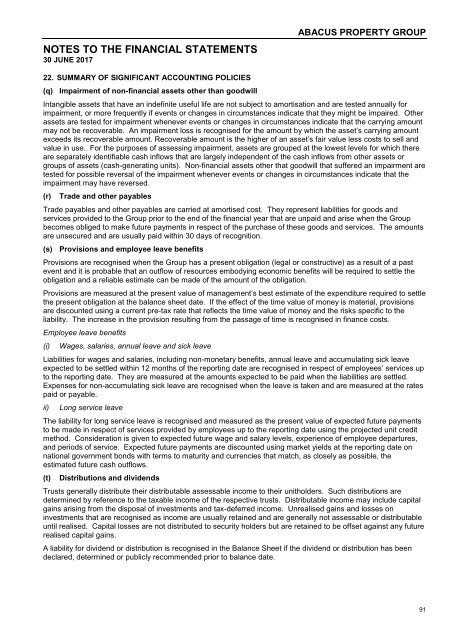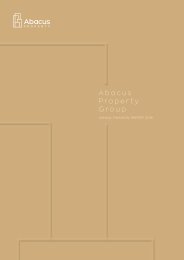Abacus Property Group – Annual Financial Report 2017
Abacus Property Group – Annual Financial Report 2017
Abacus Property Group – Annual Financial Report 2017
Create successful ePaper yourself
Turn your PDF publications into a flip-book with our unique Google optimized e-Paper software.
NOTES TO THE FINANCIAL STATEMENTS<br />
30 JUNE <strong>2017</strong><br />
ABACUS PROPERTY GROUP<br />
22. SUMMARY OF SIGNIFICANT ACCOUNTING POLICIES<br />
(q) Impairment of non-financial assets other than goodwill<br />
Intangible assets that have an indefinite useful life are not subject to amortisation and are tested annually for<br />
impairment, or more frequently if events or changes in circumstances indicate that they might be impaired. Other<br />
assets are tested for impairment whenever events or changes in circumstances indicate that the carrying amount<br />
may not be recoverable. An impairment loss is recognised for the amount by which the asset’s carrying amount<br />
exceeds its recoverable amount. Recoverable amount is the higher of an asset’s fair value less costs to sell and<br />
value in use. For the purposes of assessing impairment, assets are grouped at the lowest levels for which there<br />
are separately identifiable cash inflows that are largely independent of the cash inflows from other assets or<br />
groups of assets (cash-generating units). Non-financial assets other that goodwill that suffered an impairment are<br />
tested for possible reversal of the impairment whenever events or changes in circumstances indicate that the<br />
impairment may have reversed.<br />
(r)<br />
Trade and other payables<br />
Trade payables and other payables are carried at amortised cost. They represent liabilities for goods and<br />
services provided to the <strong>Group</strong> prior to the end of the financial year that are unpaid and arise when the <strong>Group</strong><br />
becomes obliged to make future payments in respect of the purchase of these goods and services. The amounts<br />
are unsecured and are usually paid within 30 days of recognition.<br />
(s) Provisions and employee leave benefits<br />
Provisions are recognised when the <strong>Group</strong> has a present obligation (legal or constructive) as a result of a past<br />
event and it is probable that an outflow of resources embodying economic benefits will be required to settle the<br />
obligation and a reliable estimate can be made of the amount of the obligation.<br />
Provisions are measured at the present value of management’s best estimate of the expenditure required to settle<br />
the present obligation at the balance sheet date. If the effect of the time value of money is material, provisions<br />
are discounted using a current pre-tax rate that reflects the time value of money and the risks specific to the<br />
liability. The increase in the provision resulting from the passage of time is recognised in finance costs.<br />
Employee leave benefits<br />
(i)<br />
Wages, salaries, annual leave and sick leave<br />
Liabilities for wages and salaries, including non-monetary benefits, annual leave and accumulating sick leave<br />
expected to be settled within 12 months of the reporting date are recognised in respect of employees’ services up<br />
to the reporting date. They are measured at the amounts expected to be paid when the liabilities are settled.<br />
Expenses for non-accumulating sick leave are recognised when the leave is taken and are measured at the rates<br />
paid or payable.<br />
ii)<br />
Long service leave<br />
The liability for long service leave is recognised and measured as the present value of expected future payments<br />
to be made in respect of services provided by employees up to the reporting date using the projected unit credit<br />
method. Consideration is given to expected future wage and salary levels, experience of employee departures,<br />
and periods of service. Expected future payments are discounted using market yields at the reporting date on<br />
national government bonds with terms to maturity and currencies that match, as closely as possible, the<br />
estimated future cash outflows.<br />
(t)<br />
Distributions and dividends<br />
Trusts generally distribute their distributable assessable income to their unitholders. Such distributions are<br />
determined by reference to the taxable income of the respective trusts. Distributable income may include capital<br />
gains arising from the disposal of investments and tax-deferred income. Unrealised gains and losses on<br />
investments that are recognised as income are usually retained and are generally not assessable or distributable<br />
until realised. Capital losses are not distributed to security holders but are retained to be offset against any future<br />
realised capital gains.<br />
A liability for dividend or distribution is recognised in the Balance Sheet if the dividend or distribution has been<br />
declared, determined or publicly recommended prior to balance date.<br />
91











